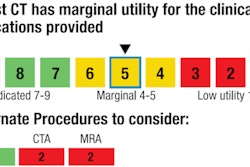Clinical decision-support (CDS) software that alerts physicians if they are about to order a duplicate imaging exam was effective in tests conducted in Massachusetts. In an April 22 article in JAMA Internal Medicine, researchers reported that doctors who used CDS software had six times the rate of canceled CT exams.
In addition to streamlining the order-entry process, CDS modules added to computerized physician order-entry (CPOE) software can advise doctors of the appropriateness and clinical value of diagnostic exams and recommend more appropriate exams, if needed. A "duplicate exam" decision-support module, whether standalone or integrated with CDS software, alerts physicians of the existence of an identical exam already performed within a specified time period.
Previous research has found that eliminating duplicate imaging in U.S. hospitals could save $3.2 billion annually, based on 2004 data. But how effective would a decision-support module be in the real world? Researchers at the Center for Evidence-Based Imaging in Brookline, MA, and at Brigham and Women's Hospital in Boston decided to find out.
The group, led by principal investigator Dr. Elliot Wasser, conducted a study to assess how a duplicate decision-support module would affect the number of repeat exams. The researchers found that physicians using the software had a cancellation rate six times higher than doctors who did not use the software. In addition, 5.1% of all orders placed for CT exams were canceled as a result of an alert (JAMA Intern Med, April 22, 2013).
Wasser and colleagues identified 32,858 clinical CT orders made using the hospital's CPOE system (Percipio, Medicalis) from January 2010 to June 2010. This represented 98% of all CT orders during this five-month period, and the exams were ordered for 21,528 patients.
Approximately one-third of the orders (11,074, or 33.7%) represented requests for potentially redundant CT exams and were considered the intervention group. The remainder, some 21,784 orders, represented a control group.
In all, 5.1% of canceled CT orders were attributable to decision-support alerts, with 6% of orders canceled in the intervention group (661/11,074) and only 0.9% in the control group (194/22,281). Activation rates for duplicate alerts varied by clinical setting, from a 5.3% rate in primary care clinics to a 48.5% rate in surgical specialty clinics.
Many of the latter alerts were overridden, however. This was probably because they involved patients who required CT exams before and after surgery, Wasser explained during an interview with AuntMinnie.com.
"In the primary care setting, almost 94% of all CT orders were entered by the physician," he said. "Within the surgical clinics, clerical workers and midlevel staff tend to enter imaging requisitions, which are later signed by the ordering provider before the exam is performed. The use of proxies for aiding order-entry workflow in all likelihood blunted the impact of the alert."
Overall, the researchers were surprised and impressed by the high level of canceled CT orders. The system had been in use since 2008, and each patient's radiology exam data were available to physicians when they created imaging orders.
"I had thought at the outset of the study that because physicians had ready access to prior exams within the 90-day time frame that triggered an alert, there wouldn't be as many alerts as there were," Wasser said.
While it hasn't been proved, some physicians may, in fact, be relying on the alert system to notify them of a potential redundant exam, saving them the time of reviewing the radiology record. CDS software is designed to push a list of prior exams to them when activated.
"When an alert was triggered, a detailed list of recent potentially redundant CT exams along with links to their images and radiology reports would be displayed," Wasser said. "The alert system was designed to encourage an ordering physician to be able to easily review this information, since the doctor clearly hadn't done it before."
The cost savings for patients, payors, and the economy from eliminating duplicate exams is considerable. The software also eliminates unnecessary radiation exposure to patients. Additionally, once the software is installed, the cost to operate it is negligible.
Overall, 1.7% of all CT orders placed during the study period were canceled as a result of the intervention by the exam alert software.
"Given the large number of CT studies performed in the United States, even small reductions in unnecessary duplication could prove beneficial," the authors wrote. "If our findings are confirmed by others, using decision support to notify providers to the presence of recent similar imaging studies may be an effective tool to reduce waste while improving patient safety."



















